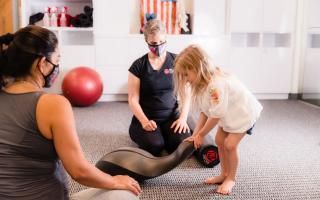
Urinary Incontenance
At Rose Physical Therapy, in Washington DC, our physical therapists teach clients a variety of techniques to improve their well-being to help reduce urinary incontinence. We work with you during our one on one treatment sessions to identify areas of need or concern, and then implement a plan of care that is specific and personalized to you.
There are three main types of urinary incontinence that physical therapists can help treat.
Stress incontinence: the involuntary loss of small amounts of urine when coughing, laughing, jumping, or participating in a physical activity.
Urge incontinence: the involuntary loss of large amounts of urine associated with an abrupt and strong desire to urinate.
Mixed urinary incontinence: a condition where both stress and urge incontinence exist.
Physical therapy can help reduce urinary incontinence and restore function and movement through techniques such as specific exercises, pelvic floor assessment done by one of our specialized therapists, biofeedback, pelvic floor exercises, bladder training, McKenzie Mechanical Diagnosis and Therapy (MDT), Active Release Techniques (ART), and many other specialized treatments. Each physical therapist works one on one with you for an hour treatment each time in order to create a specific plan of care and treatments tailored to your needs.
Pelvic floor physical therapy is a specialized form of physical therapy that targets the muscles and tissues in the pelvic region, including the pelvic floor muscles. The pelvic floor muscles support the bladder, uterus, and rectum and are responsible for controlling urination and bowel movements.
Pelvic floor physical therapy involves exercises and techniques that help to strengthen and relax the pelvic floor muscles, improve bladder and bowel control, and reduce symptoms of urinary incontinence. Techniques used in pelvic floor physical therapy may include:
- Pelvic floor muscle training (PFMT): These exercises involve contracting and relaxing the pelvic floor muscles to improve coordination, strength, and endurance.
- Bladder training: This involves gradually increasing the time between bathroom visits to improve bladder control.
- Manual therapy: internal or external muscle manipulation
- Biofeedback: This technique uses sensors to monitor muscle activity and provide feedback on how to properly contract and relax the pelvic floor muscles.
Pelvic floor physical therapy is a non-invasive and effective treatment for urinary incontinence, and it can also help to reduce the risk of future incontinence. A pelvic floor physical therapist can create an individualized treatment plan based on the specific needs and symptoms of the patient.
If you are experiencing urinary incontinence, come into Rose Physical Therapy Group for an evaluation and steps to success. Physical Therapists at our downtown Washington DC location near Dupont Circle, or our office near Navy Yard in Southeast Washington, DC. Come in and let us help you get back to doing the things you like without worrying about leaking!





